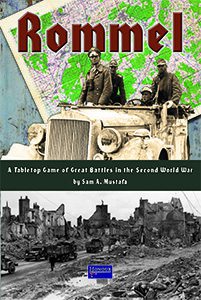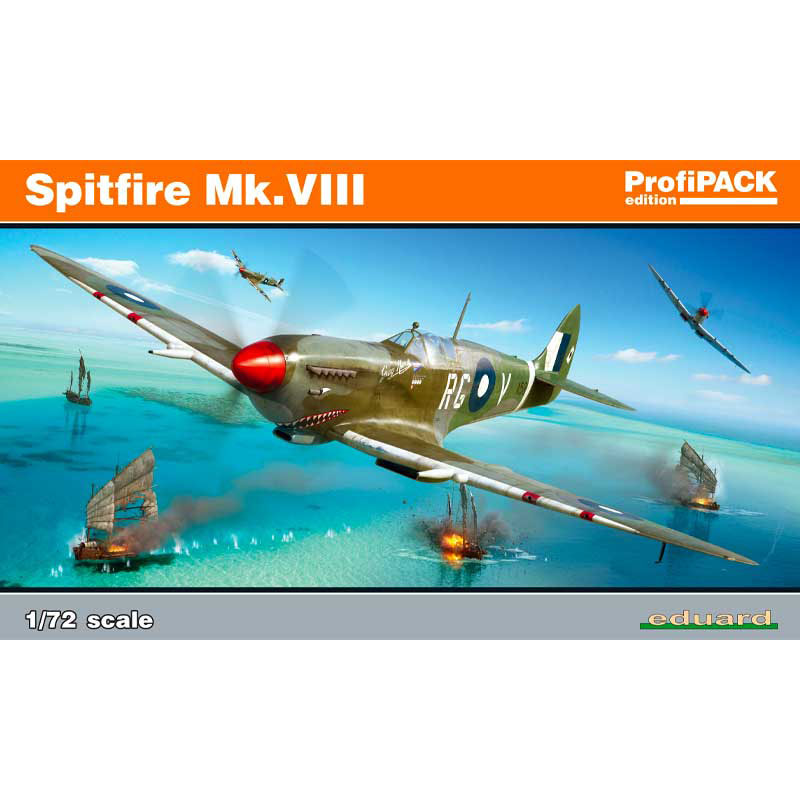
This game has been out for a few years now, and I’ve had my eye on it. It’s by Sam Mustafa, one of the world’s top wargames designers, for whom I have had a huge respect since the days of Grande Armée. Here he goes into a whole new era: WW2, and he has produced a game at operational level, to use the US military terminology (which I would otherwise call grand tactical). Each player has one or more divisions, and the playing area represents 72 square kilometres (or more…). Such games are commonplace as board games, but not on the tabletop, where games tend to have the flavour one-to-one representations, even when (for example Rapid Fire!) each piece actually represents a platoon or more. Now that I want to bring in such elements as artillery and air power to the tabletop, this is the sort of game I’m looking for. So at long last I splashed out on a copy.
I was rather underwhelmed at first. It’s quite a small book, like the Napoleonic Blucher from the same stable. The typesetting and visual appearance is similar to Blucher too, and overworked to my taste. The scantily clad 1940s girls adorning the chapter numbers may be very evocative of servicemen’s pin-ups, but it is just annoying to me, I’m afraid. The photos are a bit underwhelming too, and there aren’t many of them (though I don’t mind that so much). More seriously, as I got into the rules there seemed to be a lot missing: antitank guns, infantry guns (except when they aren’t), heavy mortars, recce units, AA units. Air power is dealt with in a very abstract way. Worse, the game structure seems very “gamey”, with each player having a “Command Post” sheet that reminds me of something similar in Saga, the very gamey Dark Ages game. The worry here is that you spend too much time playing the rules, rather than making decisions that resemble those of the historical counterparts. Sam badly overdid this in my view with his 18th century Maurice game, where players were playing hands of cards as well as troops on the table in a way that bore no resemblance to how actual generals went about their work.
But it quickly got better, though I still can’t reconcile myself to the visuals. Producing a game at this level is a tough gig if you are used to traditional style rules. You have to leave a lot out or else the whole thing gets overwhelming. This is the sort of thing that Sam is so good at. The game went through a lot of testing during which a lot of extraneous stuff was thrown out. I suppose if I want 120mm mortars, Bofors guns or Grille SP guns on the table then I need to go for a system like Rapid Fire. Likewise for model aircraft, though these could be brought in at a pinch as markers or tokens for “Events” or “Tactics”. The Command Post is much simpler than the Saga equivalent, and it is just a more sophisticated Command Point system. That may be too gamey in the end, but it’s not like playing a hand of cards.
So, what about the game? The first thing to say is that it is played on a grid of 1km squares. Practically these can’t be more than 6in (15cm) across, or else the table gets too big. That brings some challenges that I will come to. If you don’t like squares it is easy enough to adapt to hexes. The advantage of squares is twofold. Most important, they are very easy to mark out on the table using very discrete dots for the corners or the centres (the recommended method). Second is cosmetic; modern maps are marked up in a square grid, and maps played a critical part in the conduct of war at this level. Hexes make it look more like a board game. The use of squares to regulate movement, combat and artillery ranges feels like an excellent compromise for this sort of game. But it does mean that a lot geographical features get lost, like those support units: villages, roads, streams and so on.
Beyond that it really is quite hard to explain, especially since I haven’t tried playing it yet. It has an IgoUgo turn system. The player has a very limited budget of “Ops” (Command Points to you and me – I’m afraid I dislike Sam’s game terminology almost as much as his graphic design), which can be spent on movement, “Events” or “Tactics”. Doing well in combat looks expensive in points, while moving around is not so much. The combat resolution system is quite basic, but looks pretty appropriate. The whole thing is so unlike conventional games, though, it will take a little learning. As ever, Sam has thought of that, with basic rules and advanced rules, and a simple introductory scenario.
So what are my concerns? The first concerns my toys. For WW2 they are mainly 20mm, which is undoubtedly on the big side. It should be possible to get three Shermans into a 6in square (three is the stacking limit), but it would be a squeeze. There aren’t many photos of games in progress, but these mainly seem to be 6mm models on a 4in grid, with occasional 15mm or 2mm models. Undoubtedly the smaller models look better, though often I find their bases to be distracting. But 20mm models on a 6in grid will be not unlike 15mm ones on a 4in grid. Of course the missing toys grate, especially the anti-tank guns, which played such an important part in tactics of the time. The advanced rules allow what they call “tank hunters”, lightly armoured SP AT guns like the German Marder or Russian Su-76. That looked a bit of a cop-out to me – a bit of warmgamer’s bias to anything with tracks. These really are just mobile AT guns with almost no attack value. This clearly grated on early gamers too – as the downloadable optional rules contain an extra rule on massed AT guns. This is meant to represent such tactics as German Pakfronts, used by German, Soviet and British armies from mid-war on. There is also a “Tactic” to represent the presence of 88s and British 17pdrs (“Pheasants” – though I think that term only applied to the early improvised weapons on 25pdr carriages, of which I actually have a rather crude model). If you wanted to, it would be quite easy to put on heavy mortars or infantry guns, as after all the rules make occasional provision for 75mm howitzers. The issue is how concentrated these units were in practice – as an artillery unit needs to be quite beefy to get onto the table. Indeed it is quite hard for me to reconcile the presence of German 75mm guns in the early and late periods, and US pack howitzers for paras, but not American Chemical Mortar units, which played quite a significant role at Salerno, for example. Of course this game is doubtless plagued by dozens of issues like this, and you have to draw the line somewhere.
After the toys issue, I thought there was something else missing. There is no recognition of the significance of vantage points and commanding heights. That shows the influence of the Tunisian and Italian campaigns on my thinking, for my Project 1943. Commanding heights were critical objectives, and their possession influenced the direction of battles in these theatres. It was also a big deal on the Western Front in WW1, even around Ypres were on first impression the ground is pretty flat. On reflection I am feeling this is not such a big problem, as I don’t think it was such an issue in the relatively fluid battles fought across relatively flat terrain for much of the war. There are ways it can be dealt with too in the exceptional places, perhaps with the use of the Recce tactic, or other parts of the Command Post; exploiting a vantage point should surely require CPs. But that brings on another issue: the game has a fairly easy to understand open architecture when designing units, but the design of the Command Posts is less transparent. Each country (with the US and Britain treated as integrated allies) has a standard CP for each of the early, mid and late war periods. This looks as if it should work well enough for most of the time, but there will always be a case for tinkering with it, and the design aspects of this are not transparent.
Still, I feel I must give this a try. This means I must give some thought as to table design. I am not inspired by the photos of games In action. Firstly, with my 20mm models I think I need to go for an abstract look, bringing to mind maps rather than real terrain. That would men no physical terrain pieces on the table. There just isn’t room, and they look wrong. A tree is not a forest. A lone building is not a street. The terrain markings need to be flat, so that the models can go on top as glorified counters. Features can be named, including ones that have no game significance (like villages and major roads), but would have been important geographical markers. It might be a bit ambitious to give every square a name (72 squares!), but there should be enough to help navigation. I think that would do a lot to give the game atmosphere . I do have some 6mm models too, though only a US army that is ready for the table top. I was thinking of using these to try out Battlefront rules, based on the late war (perhaps the Lorraine battles in September 1944). Some thought needs to be given about these as well. It is more practical for these to have more representational terrain though the temptation is to have smaller (4in) squares, which make this harder. This is worth thinking about. I have a feeling that a weak visual appearance on the tabletop is one of the reasons these rules haven’t caught on as much as they might have done.
A final issue for me is to think about ways to make the use air power less abstract. I totally understand why Sam never attempted this – it entails a whole new layer of the game. It is purely something I need to get off my chest. Air power did have an important part to play at this level, though it was often away from the main battle front. I would like players to have air assets which they then choose to deploy to influence the battle as best they can, through front line support, air superiority, interdiction or medium level bombing. I think space could be made for this in a game like this. But a while down the track on that one!
But overall Sam Mustafa is to be congratulated in taking on a very challenging project, and coming up with solutions I would never have thought of, and giving insights into the sorts of compromises that have to be made. I am looking forward to trying these rules out. One day.
